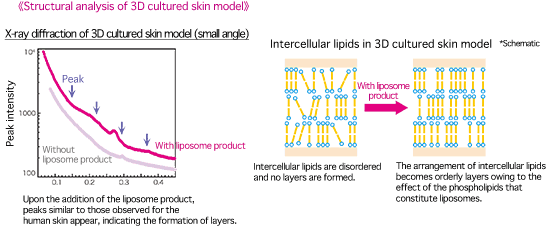Establishment of Method for Developing Stratum Corneum in Three-Dimensional Cultured Skin Models- Realized using SPring-8 beamline(Press Release)
- Release Date
- 06 Apr, 2011
- BL40B2 (Structural Biology II)
Nippon Menard Cosmetic Co., Ltd.
|
Scientists from Nippon Menard Cosmetic (H.O.: 3-18-15 Marunouchi, Naka-ku, Nagoya; President, Junichi Nonogawa) have developed a stratum corneum* for three-dimensional cultured skin models by structural analysis using a high-brilliance X-ray diffraction device at the SPring-8 Structural Biology II Beamline (BL40B2). Thus, a method of developing a stratum corneum closer to that of the human skin has been established. The stratum corneum, the outermost layer of the skin, has a barrier function to protect the body. The barrier function is strongly related to the property of intercellular lipids, which fill the gaps between corneocytes. In the stratum corneum in three-dimensional cultured skin models, however, the structure of intercellular lipids is considered to be incomplete. Three-dimensional cultured skin models are used to evaluate the safety and efficacy of cosmetics, and scientists have been attempting to improve the accuracy of such evaluations by developing models closer to the human skin. Scientists from Nippon Menard Cosmetic examined the components constituting intercellular lipids of the stratum corneum in three-dimensional cultured skin models, and focused on liposomes consisting of phospholipids, which are a constituent of the cell membrane. When their original liposome product was added to the three-dimensional cultured skin model, the structure of the intercellular lipids changed to one close to that of human intercellular lipids. This technique will lead to increased accuracy in the evaluation of the safety and efficacy of cosmetics. Moreover, the scientists have long been studying the permeability of cosmetics components using a capsulation technique with phospholipids. The permeability of newly developed cosmetics was also confirmed using the three-dimensional cultured skin model developed in this study. The results of this research were presented at the 91st Spring Meeting of the Chemical Society of Japan in March 2011. Menard will continue to study and develop three-dimensional cultured skin models closer to the human skin and contribute to the research and development of cosmetics and medicines. Publication: |
<<Glossary>>
* Structure of stratum corneum of skin
The stratum corneum is the outermost layer of the skin and consists of corneocytes and intercellular lipids. These intercellular lipids consist of various lipids including ceramides, fatty acids, and cholesterols and form a layer structure.
<<Figures>>
The human skin can serve as a barrier because intercellular lipids are regularly arranged and layers are suitably stacked. In the three-dimensional cultured skin model, however, the arrangement of the intercellular lipids of the stratum corneum is disordered; therefore, layers are not correctly formed, making the barrier function weak. When the liposome product is added to the three-dimensional cultured skin model, the arrangement of the intercellular lipids becomes orderly and layers are suitably formed, resulting in a state closer to that of the human skin.
In the human skin, intercellular lipids are regularly arranged with a high density. In the three-dimensional cultured skin model, however, the arrangement of intercellular lipids is disordered and their density is low, making the barrier function weak. When the liposome product is added to the three-dimensional cultured skin model, the arrangement of the intercellular lipids becomes orderly, resulting in a high density and a state closer to that of the human skin.
|
For more information, please contact: |
- Previous Article
- World’s First Direct Observation of Slow-Moving Electrons Derived from Cerium (Press Release)
- Current article
- Establishment of Method for Developing Stratum Corneum in Three-Dimensional Cultured Skin Models- Realized using SPring-8 beamline(Press Release)



